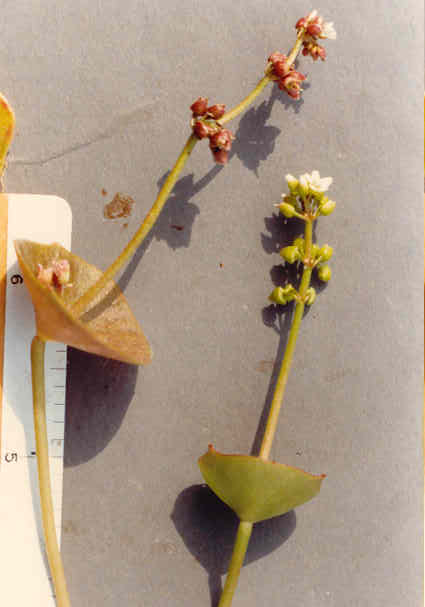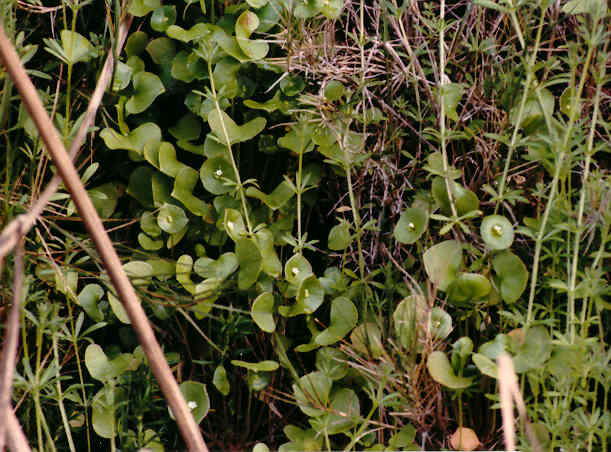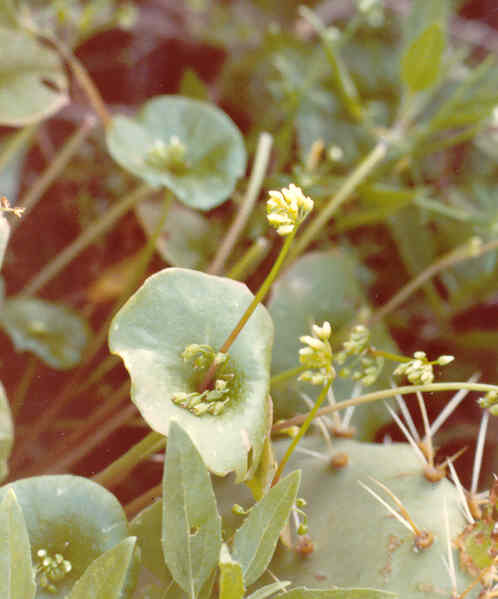
 |
Claytonia perfoliata Willd. ssp. perfoliata (C.p. Donn. var. p.)=Montia perfoliataPortulacaceae (Purslane Family)NativeMiner's LettuceCommon Miner's Lettuce |
March Photo
Plant Characteristics:
Glabrous, green annual, branched from base, 1-3 dm. high; basal lvs.
rhombic-ovate to elliptic-obovate, tip obtuse to acute, long-petioled, 5-20 cm.
long; cauline lvs. 2, opposite, connate into an oblique orbicular disk 1-8 cm.
broad; racemes +/- elongate, sessile or peduncled, the fls. usually +/- whorled;
pedicels commonly 2-8 (-10) mm. long, often recurved in fr.; sepals rounded, ca.
3-5 mm. long; petals white, clawed, obovate, 4-6 mm. long; seeds black, shining,
rounded, minutely punctate, 1-2 mm. in diam.
Habitat:
Common in +/- shaded and vernally moist places, below 5000 ft.; Coastal
Sage Scrub, Chaparral, S. Oak Wd., etc.; L. Calif. to B.C., inland to desert
edge. Feb.-May.
Name:
Named for John Clayton, 1693-1773, an American botanist and the
Attorney General for Colonial Virginia, who was the sole collector for an early
flora of Virginia. The manner in
which the stem "perforates" the leaf is most distinctive and is
expressed in the species name perfoliata.
(Dale 161).
General:
Occasional in the study area. There
are sometimes large patches of this plant in vernally moist areas.
Photographed on the Castaway's Bluffs, above Back Bay Drive between Big
Canyon and the old Salt Works dike and at the intersection of Back Bay Dr. with
Eastbluff Dr. (my comments).
Indians ate the tender, fleshy leaves raw or cooked and made a tea of the
plant to use as a laxative. Miners
used the leaves, an important source of vitamin C, as salad greens to help
prevent scurvy. This is one of the few native plants to have been introduced
into Europe. (Clarke 60).
Indians in Placer County are reported to have put the leaves near the
entrance of red ant holes. After
the ants had swarmed on the leaves, they were shaken off leaving a vinegary
taste, which was much relished. (Dale
160,161). C. perfoliata has been known to
accumulate free nitrates in quantities capable of causing death or distress in
cattle. (Fuller 384). The Cahuilla, Indians who inhabited
the Colorado Desert, the San Jacinto and San Bernardino Mountains used this
plant fresh or boiled. (Bean 89). The 1993 Jepson Manual lists ssp.
mexicana and ssp. perfoliata while Munz, Flora So. Calif.
lists var. perfoliata, var. depressa, var.
parviflora and var. utahensis. In
the spring of 1994, I confirmed that our local ssp. is perfoliata.
Highly variable; sspp. difficult because of environmental plasticity,
genetic mixing among polyploids, and geographical overlap of distinct,
self-pollinating forms. (Hickman,
Ed. 900).
Text Ref:
Hickman, Ed. 900; Munz, Calif. Flora 302; Munz, Flora So. Calif.
712; Robbins et al. 172; Roberts 34.
Photo Ref:
Mar-April 83 # 13; Feb 1 85 # 24,E; Mar 2 85 # 20; Feb 05 # 17.
Identity: by R. De Ruff.
First Found: March 1983.
Computer Ref: Plant Data 264.
Have plant specimen.
Last edit 3/3/05.
 |
 |
February Photo March Photo